
Asa Gray is considered the most important American botanist of the 19th century. His Darwiniana was considered an important explanation of how religion and science were not necessarily mutually exclusive. Gray was adamant that a genetic connection must exist between all members of a species. He was also strongly opposed to the ideas of hybridization within one generation and special creation in the sense of its not allowing for evolution. He was a strong supporter of Darwin, although Gray's theistic evolution was guided by a Creator.

Toxicoscordion fremontii, known as the common star lily or Frémont's deathcamas or star zigadene, is an attractive wildflower found on grassy or woody slopes, or rocky outcrops, in many lower-lying regions of California, southwestern Oregon, and northern Baja California.
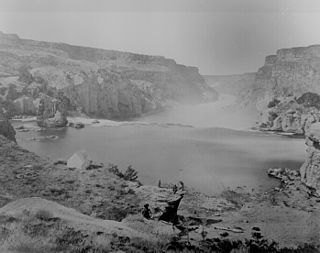
The Geological Exploration of the Fortieth Parallel was a geological survey made by order of the Secretary of War according to acts of Congress of March 2, 1867, and March 3, 1869, under the direction of Brig. and Bvt. Major General A. A. Humphreys, Chief of Engineers, by Clarence King, U. S. geologist. More commonly known as the Fortieth Parallel Survey, the survey conducted field work from 1867 to 1872, exploring the area along the fortieth parallel north from northeastern California, through Nevada, to eastern Wyoming.

Sereno Watson was an American botanist. Graduating from Yale in 1847 in Biology, he drifted through various occupations until, in California, he joined the Clarence King Expedition and eventually became its expedition botanist. Appointed by Asa Gray as assistant in the Gray Herbarium of Harvard University in 1873, he later became its curator, a position he maintained until his death. Watson was elected a Fellow of the American Academy of Arts and Sciences in 1874, and a member of the National Academy of Sciences in 1889.

Glyptopleura is a genus of North American plants in the family Asteraceae. The common names for this plant include carveseed, holy dandelion, keysia, and crustleaf.
Glyptopleura setulosa, the holy dandelion, is a species of North American plants in the family Asteraceae.

Allium atrorubens is a species of wild onion known by the common name dark red onion. This plant is native to the southwestern United States where it grows in the sandy soils of the Mojave Desert, the Great Basin and higher-elevation deserts in Nevada, eastern California southwestern Utah, northwestern Arizona.

Allium nevadense is a species of wild onion known by the common name Nevada onion. It is native to the western United States where it grows in sand and rocky soil at elevations of 1400–1700 m. The species is widespread in Utah, Nevada and southern Idaho, and has been reported also from southeastern California, northwestern Arizona, western and central Colorado and eastern Oregon.
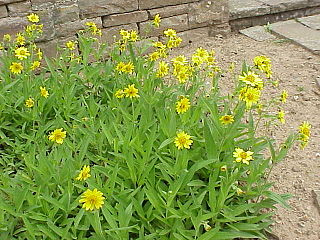
Arnica longifolia is a North American species of arnica in the sunflower family, known by the common names seep-spring arnica, longleaf arnica and spearleaf arnica. This flowering perennial is native to the forests of western Canada and the western United States.

Fimbristylis thermalis is a species of fimbry known by the common name hot springs fimbry. It is native to the southwestern United States and northern Mexico. It has been reported from Baja California, California, Arizona, Nevada, Utah and Coahuila.

Daniel Cady Eaton was an American botanist and author. After studies at the Rensselaer Institute in Troy and Russell's military school in New Haven, he gained his bachelor's degree at Yale College, then went on to Harvard University, where he studied with Asa Gray. He then went to Yale University's Sheffield Scientific School in 1864, where he was a botany professor and herbarium curator. Eaton is the grandson of Amos Eaton.

Allium bisceptrum, also known as the twincrest onion or aspen onion, is a high elevation plant native to western United States. It is a perennial that thrives under damp and shady conditions or open meadows in California, Arizona, New Mexico, Nevada, Oregon, Washington, Idaho, and Utah.
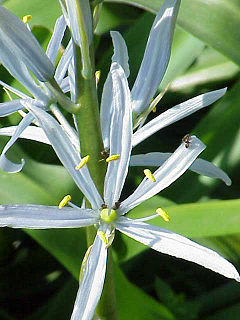
Camassia cusickii, common name Cussick's camas, is a species of plant in the family Asparagaceae. It is native to parts of North America. C. cusickii originally appeared in horticultural journals in the late 1800s, but they been sold and cultivated for about thirty years. This plant family is not studied intensely. Seven or eight species exist in the wild, however, only three are talked about and cultivated.
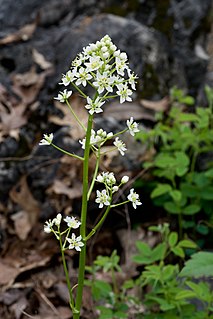
Toxicoscordion nuttallii is a species of poisonous plant native to the south-central part of the United States.
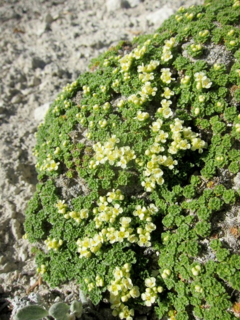
Lepidium nanum, the dwarf pepperweed, is a plant species native to the US states of Nevada and Utah. It is known from four counties in Nevada but only one in Utah. It occurs in open, sunlit areas in the desert, often with gypsum, limestone, quartzite or chalky soils.
Allium bigelovii, the New Mexico wild leek, is a plant species native to Arizona and southwestern New Mexico. It grows on open, gravelly slopes at elevations of 500–1,700 m (1,600–5,600 ft).

Allium brevistylum is a plant species native to the western United States. It grows in meadows and along stream banks high in the mountains of Colorado, Utah, Wyoming, Montana and Idaho, at elevations of 2200–3400 m.

Calochortus gunnisonii is a North American species of flowering plant in the lily family. It is native to the western United States, primarily in the Rocky Mountains and Black Hills: Arizona, New Mexico, Utah, Colorado, Wyoming, Montana, South Dakota, Washington state (Grant County, northwestern Nebraska and eastern Idaho.

Enceliopsis argophylla, commonly known as the silverleaf sunray, is a North American species of flowering plant in the family Asteraceae. Other common names include nakedstem sunray and naked-stemmed daisy. It is native to the southwestern United States: Arizona, Nevada, and Utah, and can be seen a short distance east of Las Vegas, Nevada.

Erythranthe carsonensis is a species of monkeyflower known by the common name Carson Valley monkeyflower.


















